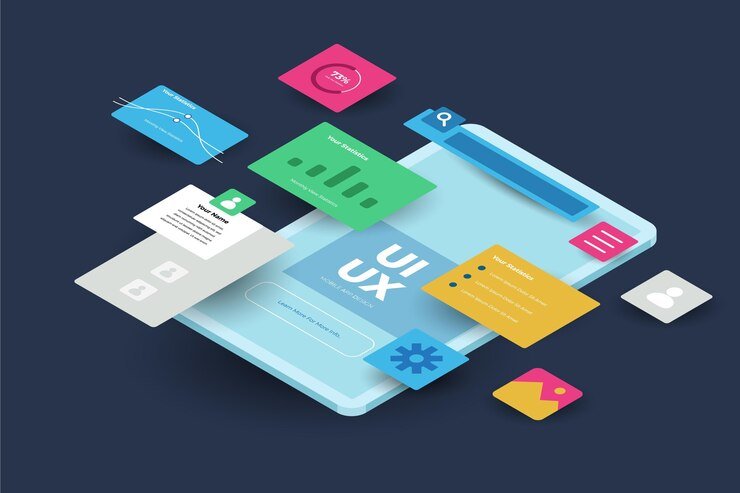UI/UX Design Roadmap: A Step-by-Step Guide to Mastering the Craft
UI/UX design is an exciting field that blends creativity, psychology, and technology to deliver user-friendly digital products. Whether you’re just starting or planning to enhance your skills, this roadmap will guide you through the key stages of becoming a proficient UI/UX designer.
What is UI/UX Design?
- UI (User Interface) Design focuses on the visual aspects of a product, such as buttons, typography, and color schemes.
- UX (User Experience) Design ensures seamless interaction by focusing on usability, user flow, and overall satisfaction when using the product.
The Ultimate Roadmap to UI/UX Design
Step 1: Understand the Basics of UI/UX Design
Before diving into tools, start by learning the foundational principles of design. Some areas to cover include:
- User-centered design (designing with the user in mind).
- Basic psychology (understanding user behavior).
- Design principles (contrast, alignment, repetition, and proximity).
- Difference between UI and UX Design to know how they complement each other.
Step 2: Learn UI/UX Tools and Software
Proficiency with industry-standard tools will improve both your productivity and creativity. Some must-learn tools include:
- UI Design Tools:
- Figma
- Adobe XD
- Sketch
- InVision
- Prototyping Tools:
- Axure RP
- Marvel App
- UX Research Tools:
- Hotjar
- UserTesting
- Google Analytics
Start with one tool and gradually explore others to diversify your skillset.
Step 3: Master Wireframing and Prototyping
Wireframes are blueprints that outline the basic layout of an interface, while prototypes simulate the real user experience.
- Low-fidelity Wireframes: Rough sketches to visualize the structure.
- High-fidelity Wireframes: Detailed, interactive designs closer to the final product.
Step 4: Understand User Research and Testing Techniques
Creating exceptional designs requires understanding the target audience and testing assumptions. Key methods include:
- Surveys and Interviews: Collecting user insights directly.
- Usability Testing: Observing users interact with your product.
- A/B Testing: Testing multiple versions of a design to see which performs better.
Learning how to analyze the data from these tests will help you improve your designs effectively.
Step 5: Study Visual Design Principles
As a UI designer, your visual design skills are critical. You’ll need to develop an eye for:
- Typography: Choosing readable and appropriate fonts.
- Color Theory: Understanding color psychology and combinations.
- Spacing and Layout: Ensuring consistent, balanced designs.
Step 6: Work on Real-World Projects
Theory alone isn’t enough—you’ll need hands-on experience.
- Freelance or Internship Opportunities: Find real-world projects through platforms like Upwork or Fiverr.
- Collaborate with Developers: This will help you understand technical constraints and build designs that are easier to implement.
- Design Challenges: Participate in design competitions or create conceptual projects to strengthen your portfolio.
Step 7: Build a Strong Portfolio
A well-organized portfolio is essential for attracting clients or landing a job. Include:
- Case Studies: Document your design process, including challenges and outcomes.
- Variety of Projects: Include both UI and UX work (websites, apps, dashboards, etc.).
- Before and After Comparisons: Show the impact of your designs on user engagement or business metrics.
Step 8: Stay Updated with Industry Trends
UI/UX is a rapidly evolving field. To stay competitive:
- Follow design blogs and forums (Dribbble, Behance, UX Collective).
- Join communities (Slack groups, LinkedIn forums).
- Attend webinars and design conferences to learn from industry experts.
- Experiment with New Tools and Frameworks such as Webflow or Material Design.
Step 9: Apply for UI/UX Design Jobs or Start Freelancing
Once you’re confident in your skills, start applying for UI/UX roles or consider freelancing.
- Entry-level roles: Junior UI/UX Designer, Product Designer, or Visual Designer.
- Freelance platforms: Showcase your portfolio to attract clients.
Conclusion
Mastering UI/UX design takes time, effort, and continuous learning. By following this roadmap, you’ll build the skills needed to create user-friendly, visually appealing products. Stay curious, keep practicing, and never stop learning—great designs are born from experimentation!
FAQs:
What are the career opportunities in UI/UX design?
You can work as a UI/UX designer, product designer, user researcher, or freelance consultant.
How long does it take to become a proficient UI/UX designer?
Depending on dedication, it can take 6-12 months of consistent learning and practice.
Do I need coding skills to be a UI/UX designer?
While coding isn't mandatory, basic HTML/CSS knowledge helps communicate with developers effectively.
What’s the difference between UI and UX design?
UI focuses on the look and feel of the product, while UX focuses on functionality and user satisfaction.
